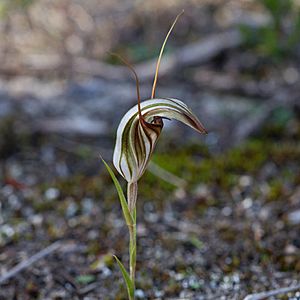Long-tongued shell orchid facts for kids
The Long-tongued shell orchid (Pterostylis dolichochila) is a special type of orchid that only grows in southern Australia. It's known for its unique green and white flower with reddish-brown stripes. Like many orchids, this plant looks different depending on whether it's flowering or not. When it's not flowering, it has a group of leaves close to the ground. But when it's ready to bloom, a single flower grows on a tall stem with leaves wrapped around it.
Quick facts for kids Long-tongued shell orchid |
|
|---|---|
 |
|
| Pterostylis dolichochila growing in the Monarto Conservation Park | |
| Scientific classification | |
| Genus: |
Pterostylis
|
| Species: |
dolichochila
|
| Synonyms | |
|
Diplodium dolichochila (D.L.Jones & M.A.Clem.) D.L.Jones & M.A.Clem. |
|
Contents
What Does It Look Like?
The Long-tongued shell orchid is a plant that lives on the ground. It's a perennial herb, which means it lives for many years. It also has an underground tuber, which is like a small storage organ.
Leaves and Non-Flowering Plants
When the orchid is not flowering, it has a group of four to ten egg-shaped leaves. These leaves form a rosette, which means they grow in a circle close to the ground. Each leaf is usually about 4 to 12 mm long and 3 to 8 mm wide.
Flowers and Flowering Plants
When the orchid is ready to flower, it grows a single bloom on a stem. This stem can be 50 to 150 mm tall. There are also three or four leaves wrapped around the stem. The flowers are green and white with reddish-brown stripes. Each flower is about 20 to 25 mm long and 7 to 9 mm wide.
Flower Parts
The top part of the flower, called the dorsal sepal, and the petals are joined together. They form a hood, or "galea," over the central part of the flower called the column. The dorsal sepal curves forward and has a sharp point or a thin, thread-like tip. This tip is usually 1 to 2 mm long.
The side sepals, called lateral sepals, are held close to the hood. They have an upright, thread-like tip that is 15 to 20 mm long. There's a wide, flat space, or "sinus," between the bases of these sepals. The "lip" of the flower, known as the labellum, is brown and curved. It's about 13 to 15 mm long and 4 mm wide. This labellum sticks out above the sinus.
Flowering Time
You can usually see these orchids flowering from April to August.
How It Was Named
The Long-tongued shell orchid was officially described in 1985. It was named by two botanists, David Jones and Mark Clements. The description was published in a book called Flora of South Australia.
Meaning of the Name
The scientific name for the species, dolichochila, comes from two Ancient Greek words. "Dolichos" means "long," and "cheilos" means "lip." This name perfectly describes the orchid's long, protruding labellum, or "lip."
Where It Grows
The Long-tongued shell orchid likes to grow in sandy soil that contains calcium carbonate (like chalk or limestone). Sometimes, many of these orchids grow together, forming large groups. You can find them in the "mallee" areas of south-eastern South Australia. They also grow in the Little Desert and Big Desert areas of Victoria.

